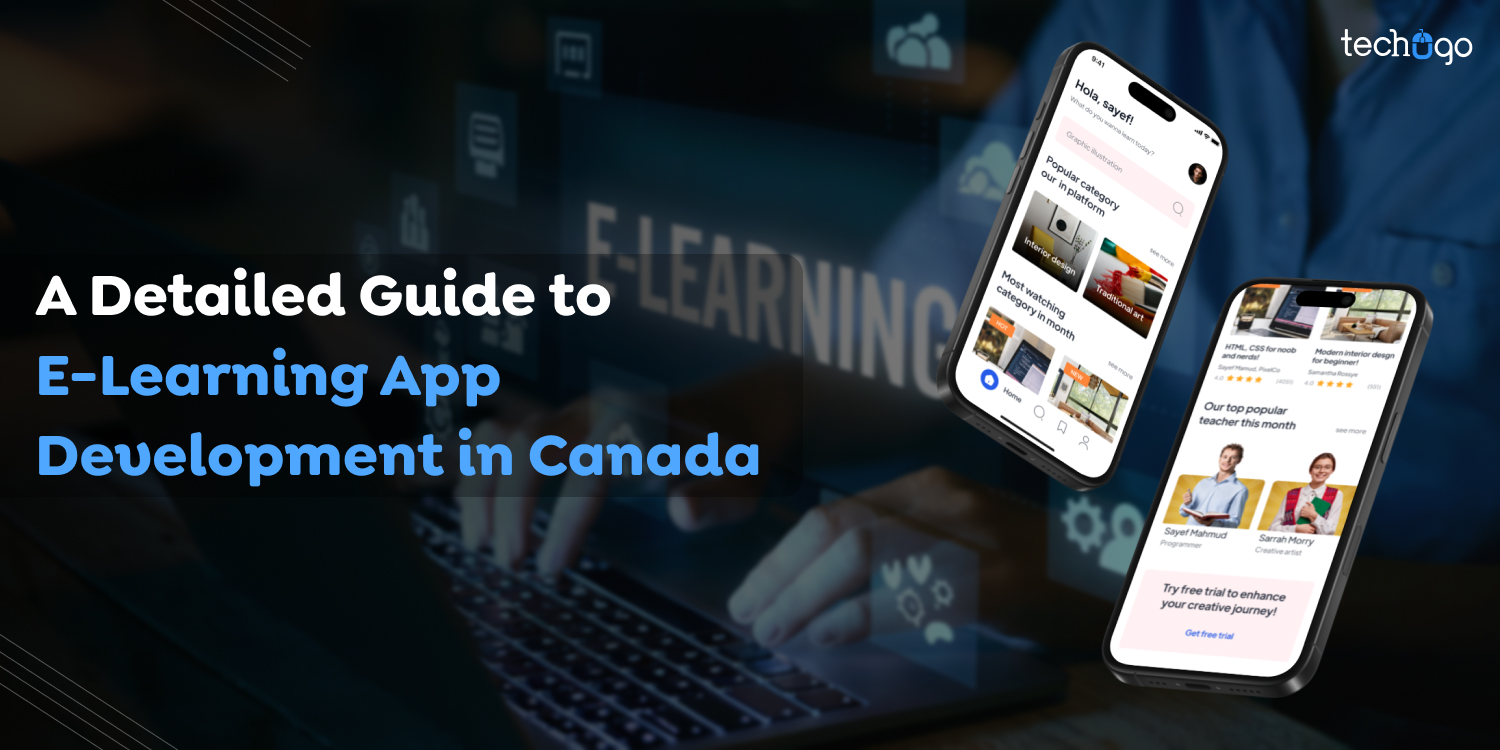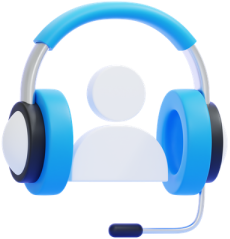21 Feb 2025
A Detailed Guide to E-Learning App Development in Canada
Matthew Connor

Education is often regarded as the single most powerful weapon in today’s world. In an age dominated by the internet, virtual classrooms have become a means of studying just as effectively as in-person education. eLearning app development is rapidly becoming a reality and is gaining popularity each year.
The market for e-learning in Canada is projected to reach an estimated revenue of CAD 96,027.69 million by 2030. The compound annual growth rate for the e-learning and learning services market in Canada is predicted to be 20.7% from 2025 to 2030. For universities and schools, eLearning app development allows them to reach out to remote students. Business owners benefit from an efficient way to communicate and onboard employees.
In response to this growth, businesses and institutions are developing innovative ways to deliver information through modern, feature-rich educational applications. This makes mobile e-learning app development a lucrative investment opportunity.
This article will cover all the information you need to know about eLearning app development.
What is eLearning App Development?
eLearning app development simply refers to the process of developing applications for mobile devices or websites that provide educational content and learning experiences. These apps are designed to enhance the overall experience for employees, students, and businesses. They offer a variety of educational resources, enabling users to easily acquire new skills.
The eLearning app development process includes design, market research, and the creation of functional features. It facilitates seamless interactions using multimedia, assessment tools, collaboration tools, and gaming elements, all aimed at making learning more engaging and accessible.
The primary objective of an eLearning app is to enhance the learning experience by making it easier, more engaging, and personalized for each user. These apps support various learning methods, such as autonomous learning, blended learning, microlearning, and more. Depending on the user’s goals, educational apps can be classified into categories such as open-source cloud, cloud-based academic, corporate, and mobile apps. Each type offers distinct advantages and features.
Types of eLearning App Development
Before beginning the process of custom eLearning app development, it is important to choose the right type. The most popular types of e-learning apps can be classified based on their features, the target audience, and the learning goals. Here are some of the most popular types:
Learning Management System (LMS)
An LMS is a software application developed to assist in the administration, delivery, tracking, and monitoring of educational courses and training programs. These systems are used by universities, schools, and businesses for various purposes, such as employee training and academic learning. They are compatible with online, mobile, and hybrid learning strategies.
Corporate Training Apps
These digital platforms help companies boost employee productivity and professional development. They feature instructional modules that include interactive lessons, quizzes, and video tutorials. Additionally, they provide employers with real-time feedback and data analytics to help assess employees’ progress.
Apps for Learning Through Courses
An app for learning through courses is a platform that provides structured learning material via courses, often requiring a subscription. It typically offers a range of interactive courses (such as video lectures and quizzes) designed to teach specific topics or skills. The platform enables app users to learn at their own pace and earn certifications upon completing the course.
Apps for Mobile Learning (mLearning)
An mLearning app is an educational platform designed for smartphones that provides content that can be downloaded anytime and from any location. The app includes quizzes, videos, and progress-tracking features to help users learn in bite-sized formats while on the go.
Fun Educational Games for Children
These apps aim to combine entertainment with education, making learning more enjoyable for kids. They feature interactive and engaging activities that focus on basic skills such as reading, creative thinking, and social-emotional development. Children can retain and learn knowledge more effectively through games and game-based apps.
Virtual Classes
Virtual classroom applications are online platforms that allow for live, interactive classes. They provide real-time connectivity between students and teachers for discussions, lessons, and activities. These platforms also include tools like video conferencing and screen sharing.
Massive Open Online Courses (MOOCs)
A MOOC is a platform that offers online courses accessible to a wide audience, typically at no cost or for a low price. These courses are provided by colleges or universities, and industry experts, which includes a variety of subjects and skills. Most MOOCs offer certificates of completion, and some have university affiliations and set schedules. However, they also allow students to learn at their own pace.
Why Should You Invest in E-Learning App Development?
There are a variety of advantages that these apps provide to businesses. What are the reasons for developing educational software to support your business with e-learning? Let’s start by addressing the “why.” Here are the top reasons you should consider investing in eLearning app development:
User Comfort and Flexibility
The primary reason these applications are so popular is their convenience for users. Almost everyone has a smartphone, while not everyone has access to a laptop. It’s much more convenient to complete a quick class on a mobile device while on the bus, waiting in line, or during any other spare time. For those running an eLearning business, this means expanding the client base and increasing customer engagement.
New Target Market
The rise of mobile apps allows businesses to reach new users and cater to their specific needs. In particular, it is especially beneficial for expanding internationally by offering a product that users can access anywhere. This can also increase the variety of income sources.
Various Monetization Options
Companies can choose from different monetization strategies, such as paid subscriptions, freemium models (where basic functions are free and advanced features are paid), in-app advertisements, or sponsorships. Customers can benefit from this as well, since it’s often more affordable than other educational options.
Huge Market Potential
The market for mobile education apps has been steadily growing as well as shows no signs of slowing down. There is a public demand for easy, effective education options. E-learning applications provide international education, allowing students to study with experts and educators from around the world. This helps broaden their horizons and introduce them to new ideas and perspectives.
Must-Have Features of eLearning App Development
Each eLearning app development service may differ, but they all share the same objective: to help users learn. Regardless of the form or purpose behind your educational app, it should include these basic features:
User Accounts
Students and instructors need an option to register and manage their accounts using an email address, phone number, or password. To make this easier, you can also offer registration via social media platforms, such as Meta. Once an account is set up, each user will be given a role that defines their level of access: student, instructor, or administrator.
Search Options
A search engine is crucial for online learning platforms that act as catalogs of teaching resources. An efficient search engine helps users easily find topics or courses that match their interests or previous learning. Key features include a keyword search bar, category navigation, and filters for ability level and language. This not only saves time but also reduces stress for users.
Course Pages
Course pages are essential for providing students with a clear outline of the class. These pages should include important details such as author information, the syllabus, course materials, and the topics covered. It is also helpful to provide certificates of achievement and feedback from past participants. An organized and user-friendly course page helps students make informed decisions about enrolling.
Progress and Assessments
Since self-study is a popular choice among users, apps must be able to track learning progress and provide assessments (tests and questions). Students can very easily monitor their progress and stay motivated to achieve their educational goals. Teachers can use this feature to track class progress and offer assistance when needed.
Video-Based Content
Videos can be extremely helpful for students, allowing them to listen to or watch recordings of lessons at any time. This ensures they don’t miss out on classes, making it a vital feature for high-demand e-learning applications.
Push Notifications
Push notifications help students stay on track by alerting them to upcoming classes or deadlines. They also encourage regular study habits. However, it’s important to maintain a balance and provide periodic updates, not frequent notifications, to avoid overwhelming users and ensure the notifications are meaningful.
Personalized Dashboards
Customized dashboards provide a visually appealing experience for users to monitor their progress, find upcoming and new classes, and receive advice tailored to their needs.
Methods of Payment
To take paid online courses, users need access to a variety of secure payment options like debit and credit cards, digital wallets, and other popular payment platforms. Ensuring the safety of personal data is vital for building trust with users. Additionally, user profiles must offer easy ways to control, manage, and update financial settings.
Multilingual Support
A good app will offer materials, including instructions and the interface, in multiple languages, making it accessible to users around the world. The more languages included in the app, the greater the number of students who can benefit from it. This feature helps reduce language barriers, increases user engagement, and provides a more personalized learning experience.
Teacher Profiles to Assist Students
Teacher profiles help instructors manage classes, track students’ progress, and interact directly with them. Key features include the ability to upload course materials, assign tasks, and provide feedback. Teachers can also monitor their students’ performance and adjust their teaching methods to better meet the students’ needs.
Advanced Features to Implement in Your E-Learning App
When creating an e-learning app or any other mobile app, it’s possible to use standard native tools to create essential functions. For more advanced capabilities, professional help may be required. Here are a few advanced features your app could include:
Interactive Learning
Interactive learning makes the learning experience more enjoyable and engaging, especially for children and teenagers. The interactive elements of your app could include features like video simulations, interactive games, and live-streamed discussions that help students better understand and retain the information.
Offline Access
The offline feature is valuable, allowing students to access learning resources even when they’re not connected to the internet. This is particularly useful for those who may not always have a stable internet connection, enabling them to continue learning regardless of their location.
Microlearning Modules
Microlearning modules consist of brief, targeted learning sessions focused on a specific topic or skill. They are designed to break down complex knowledge into smaller, digestible chunks. Students can complete these courses quickly, which promotes regular participation and helps reduce cognitive overload.
Progression Tracking
Progress tracking visually displays students’ achievements and the tasks they still need to complete. It helps students monitor their progress and stay motivated to achieve their learning goals. Teachers can also use this tool to track student progress in class and provide support whenever needed.
Assessment Tools
Assessment methods vary and can include tests, quizzes, and other techniques to evaluate students’ understanding of the subject. These tools help instructors identify areas for improvement and monitor overall performance, while also reducing stress for students through gamified assessment methods.
E-learning App Development Process: Step-by-Step
Creating educational applications involves various steps. Below is the step-by-step procedure to guide you through the process.
Set Out Your Goals
The first step is to define your goal. However, this is just one part of the process of eLearning app development. This includes deciding on your intended user, the purpose you want to convey through your app, and the statement you wish to convey with the aid of your application.
To develop a beneficial and enjoyable application, you must be aware of your audience’s requirements, preferences, and goals. Pick the information or abilities you want users to acquire using your app. Specific goals can guide the development process and help you create high-quality apps.
Conduct Market Research
When you’ve developed a concept, the next step is to conduct market research and determine if similar e-learning applications exist and what characteristics they provide. There are gaps in the market, so figure out how to differentiate your app from the competition.
Study the present educational app sector to identify potential competitors and business opportunities. Find areas where your app could add value or fill in the gaps. Consider feedback and user reviews to discover an application’s strengths and weaknesses.
Assemble Your App’s Structure and Features
Develop a detailed app design including the architecture of your app as well as user interface and features. The format you choose for your app is vital: it may be more visually appealing or based on exercises and tests. Which design style do you like for your application? Are you looking for the app to be more fun or more educational?
Be aware that the right E-learning applications’ functionality draws in a lot of customers and makes them want to download the app. Select the most important features you want to include like assessments, classes and progress tracking, as well as interactive elements. Create user flows and design of the screen to show what the app appears like and operates.
Design the User Interface (UI)
Make improvements to your app’s design. Develop a user interface which is easy to use and most importantly visually appealing to your target audience. To create a smooth and engaging user experience, pay attention to elements such as the color scheme, typography, and layout.
Be aware that UI design should encourage engagement and learning while being visually pleasing. To provide the best experience for your learners, collect feedback regularly from your users and allow your mobile e-learning development team to make necessary design adjustments
Develop Your App
The development and implementation of the app’s functions and features is an integral part of this procedure. Make use of frameworks, or platforms to simplify the development process for applications. The app can be created by a reputable eLearning app development company.
You could work with a development team and delegate the task to specialists. At this stage, it’s important to assemble your development team. Members should be dedicated and knowledgeable about app development and the e-learning field. It is also essential to determine the development cost of e-learning for your specific situation.
Test and Iterate
Conduct thorough tests to find any bugs or usability issues. To improve and expand your app, gather feedback from beta testers and potential users. Once you’re satisfied with your app’s performance, implement changes incrementally based on user feedback.
Integrate analytics software into your app to collect data on user engagement, activity, and other development-related information. You can use this data to understand how users interact with your app and plan future improvements or updates.
Launch and Update
Make a launch plan for your app that includes strategies for promotion and marketing. Improve your listing on the app store with the right keywords and appealing description. Utilize social media, online forums, as well as other marketing methods to get the word out and attract people to your application.
Invite users to look over and give feedback on the app. Examine the frequency of inputs to find opportunities for improvement to implement updates or additional features when needed. Create your application continuously in order to keep up with the evolving demands of your market.
Be aware that the creation of an educational application is an ever-changing process that demands continuous maintenance and improvements to ensure its effectiveness as well as its relevance throughout the years. Make sure that your app is updated, professional and brimming with fresh information.
How Much Does it Cost to Make an Educational App?
The cost of developing educational apps depends on several factors, including the app’s features, complexity, and type, such as animation and other advanced features. The development timeline includes various testing phases, which may require adjustments and modifications to the app. These factors directly influence the overall cost of creating an educational app.
In this case, the application’s security is among the main components. Because the application for educational purposes contains different information regarding within the database, integrity is vitally important.
The cost of development can be greatly different based on the region. For example, constructing an application within the US or Canada is generally higher priced than in Eastern European countries, with high-quality options with lower costs. A rough estimate is that the development of a basic app for e-learning could cost anywhere from CAD 8,000 to 95,000 CAD. In contrast, sophisticated apps with high-end features can cost more than CAD 100,000, according to the particular requirements and functions.
Modern Edge Technologies Used to Develop Elearning Apps
There are many techniques used to train developers of cross-platform apps to enhance their apps user-friendliness and efficiency. We’ll look at a few of them.
AI
Artificial Intelligence is extensively used to develop apps, mostly to improve user experience. AI can help track a child’s and teacher’s progress. The data collected can be used to improve the content or suggestions in the application.
Blockchain
This tech integrated into educational apps helps ensure authenticity and security. It can also help prevent numerous data security threats and potential cybersecurity issues, which is why it’s an essential component of educational app development.
Big Data
It also aims to monitor various essential information regarding the learning process for teachers, students, and parents when necessary. According to research, apps can help create an individual learning program to improve students’ performance. Therefore, this technology is essential to provide daily reports and performance tracking in the application.
AR/VR
Augmented and Virtual Reality technology is intended to improve student’s learning experience and make it more similar to reality and superior. For instance, it could be utilized as a virtual tour to help students understand abstract ideas. This certainly makes online education an excellent option!
Gamification
It is more of a method than technology because it is an entire concept or method for education. This implies an approach to learning when it is delivered through games. The app can be used for scores, points, live games, coins, etc. It can also be an effective solution, not just for children but also for the older generation.
Let’s Wrap Up
Educational apps have revolutionized the education industry. eLearning app development has proven to be among the most trusted tools for both teachers and students. An increasing number of students and educators are embracing these apps, indicating that the education sector, along with the EdTech app development industry, holds significant potential for future success.
Mobile applications are opening doors to new possibilities in this sector and becoming increasingly appealing to businesses and investors around the world. Thanks to features such as personal learning courses and video streaming, these applications can satisfy the requirements of demanding students and provide remarkable results, both in income and learning outcomes.
Therefore, it is best not to spend too much time thinking about it. If you’ve got an idea for a brand new and exciting educational app, make the most of this chance. You must decide now to select the features you want to include, hire the developers of your learning apps, and start working!
Get In touch
We are excited to here from you and let’s start something special Together. Call Us for any inquiry.
Write us
sales@techugo.caJust a call away
About you




